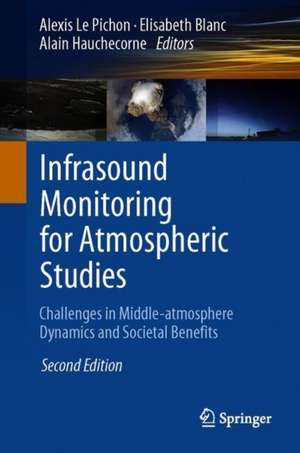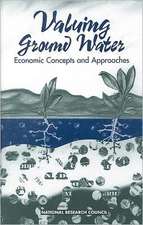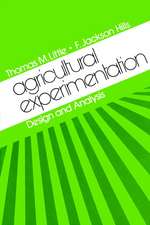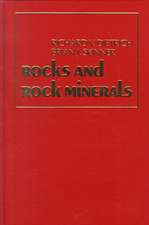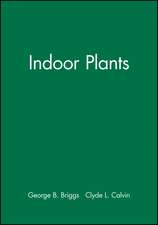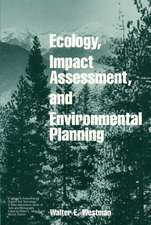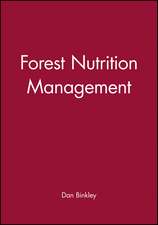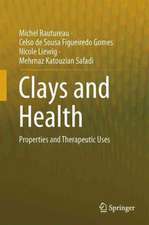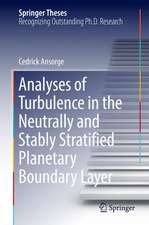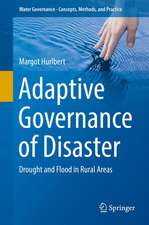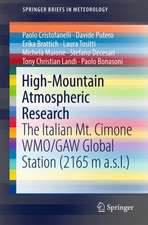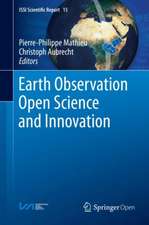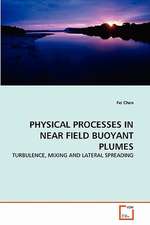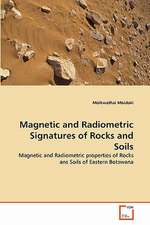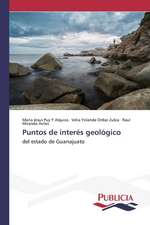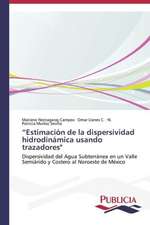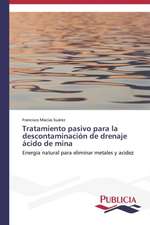Infrasound Monitoring for Atmospheric Studies: Challenges in Middle Atmosphere Dynamics and Societal Benefits
Editat de Alexis Le Pichon, Elisabeth Blanc, Alain Hauchecorneen Limba Engleză Hardback – 5 dec 2018
Preț: 1590.56 lei
Preț vechi: 1939.71 lei
-18% Nou
Puncte Express: 2386
Preț estimativ în valută:
304.45€ • 330.81$ • 255.90£
304.45€ • 330.81$ • 255.90£
Carte disponibilă
Livrare economică 31 martie-14 aprilie
Preluare comenzi: 021 569.72.76
Specificații
ISBN-13: 9783319751382
ISBN-10: 3319751387
Pagini: 800
Ilustrații: XXVIII, 1167 p. 494 illus., 423 illus. in color.
Dimensiuni: 155 x 235 x 67 mm
Greutate: 1.77 kg
Ediția:2nd ed. 2019
Editura: Springer International Publishing
Colecția Springer
Locul publicării:Cham, Switzerland
ISBN-10: 3319751387
Pagini: 800
Ilustrații: XXVIII, 1167 p. 494 illus., 423 illus. in color.
Dimensiuni: 155 x 235 x 67 mm
Greutate: 1.77 kg
Ediția:2nd ed. 2019
Editura: Springer International Publishing
Colecția Springer
Locul publicării:Cham, Switzerland
Cuprins
Part 1: Instrumentation, network and processing.- Chapter 1.The IMS Infrasound Network: Status and state-of-the-art design (Julien Mary).- Chapter 2. New generations of infrasound sensors: Technological developments and calibration (G. Nief).- Chapter 3. New systems for wind noise reduction for infrasonic measurements (Jeremy Webster).- Chapter 4. Geoacoustic observations on drifting balloon-borne sensors (Daniel C. Bowman).- Chapter 5. Measuring infrasound from the maritime environment (Doug Grimmett).- Chapter 6. Advances in operational processing at the International Data Center (Pierrick Mialle).- Chapter 7. Infrasound signal detection: Re-examining the component parts that make up detection algorithms (Omar Marcillo).- Chapter 8. Explosion source models (Milton A. Garces).- Part 2: Observations - From local to global.- Chapter 9. The ANTARES explosion observed by the US-ARRAY: an unprecedented collection of infrasound phases recorded from the same event (Julien Vergoz).-Chapter 10. Characterization of the infrasonic wave field from repeating seismo-acoustic events (Steven J. Gibbons).- Chapter 11. On the use of a dense network of seismo-acoustic arrays for near-regional environmental monitoring (Il-Young Che).- Chapter 12. Large meteoroids as global infrasound reference events (Christoph Pilger).- Chapter 13. Systematic array processing of a decade of global IMS infrasound data (Lars Ceranna).- Part 3: Propagation modeling, network performance and inversion methods.- Chapter 14. Meteorology, climatology, and upper atmospheric composition for infrasound propagation modeling (Douglas P. Drob).- Chapter 15. Propagation modeling through realistic atmosphere and benchmarking (Roger Waxler).- Chapter 16. Internal gravity wave perturbations and their impact on infrasound propagation in the atmosphere (Igor Chunchuzov).- Chapter 17. Modeling the detection capability of the global IMS infrasound network (Alexis Le Pichon).- Chapter 18. Advances in infrasonic remote sensing methods (Jelle D. Assink).- Part 4: Evaluating and improving global circulation and climate models and weather forecasts (GCM).- Chapter 19. Continuous middle-atmospheric wind profile observations by Doppler microwave radiometry (Rolf Rüfenacht).- Chapter 20. Gravity-wave detection in the mesosphere using airglow spectrometers and meteor radars (R.E. Hibbins).- Chapter 21. Detection of infrasound signals and sources using a dense seismic network (Catherine D. de Groot-Hedlin).- Chapter 22. Calculating atmospheric gravity waves parameters from infrasound measurements (Graeme Marlton).- Chapter 23. The study of sudden stratospheric warmings using infrasound (Pieter S. M. Smets).- Chapter 24. Recent dynamic studies on the middle atmosphere at mid- and low-latitudes using Rayleigh Lidar and other technologies (Alain Hauchecorne).- Chapter 25. Large scale and transient disturbances and trends: from the ground to the ionosphere (Jan Laštovi?ka).- Chapter 26. Temperature trends observed in the middle atmosphere and future directions (P. Keckhut).- Chapter 27. Non-orographic gravity waves: representation in climate models and effects on infrasound (D. Cugnet).- Chapter 28. Middle atmosphere variability and model uncertainties as investigated in the framework of the ARISE project (Elisabeth Blanc).- Chapter 29. The potential impact of upper stratospheric measurements on sub-seasonal forecasts in the extra-tropics (Andrew J. Charlton-Perez).- Part 5: Benefits for monitoring natural hazards.- Chapter 30. Infrasound for detection, localization and geometrical reconstruction of lightning flashes (Thomas Farges).- Chapter 31. Infrasound monitoring as a tool to characterize impacting Near-Earth Objects (NEOs) (Elizabeth A. Silber).- Chapter 32. Local volcano infrasound monitoring (Jeffrey B. Johnson).- Chapter 33. Volcano infrasound and the International Monitoring System (Robin S. Matoza).- Chapter 34. Atmospheric control on ground- and spacebased remote detection of volcanic ash injection into the atmosphere, and link to early warning systems for aviation hazard mitigation (Benoit Taisne).- Chapter 35. Infrasound monitoring of volcano-related hazards for civil protection (Maurizio Ripepe).- Chapter 36. Infrasound monitoring of volcanic eruptions and contribution of ARISE to the Volcanic Ash Advisory Centers (Emanuele Marchetti).
Notă biografică
A. Le Pichon (Master’s Degree in Fundamental Physics., Ph.D. in Acoustics). Research Director at Commissariat à l’Energie Atomique (CEA) in charge of infrasound research activities on topics relevant to the Comprehensive Nuclear-Test-Ban Treaty Organization (CTBTO): signal processing for automated detection and source location procedures; propagation modeling; and methods for source characterization.
E. Blanc (Research director at CEA). Main research areas are infrasound, gravity waves, and electrodynamical coupling of atmospheric layers. She coordinated international projects concerning infrasound monitoring; space observations of lightning and sprites (LSO and TARANIS); and the Atmospheric dynamics Research InfraStructure in Europe (ARISE) project dedicated to multi-instrument observations of middle atmospheric disturbances and their impacts on weather and climate.
A. Hauchecorne (Emeritus Research director at CNRS). Main research areas are dynamics and climatology of the middle atmosphere; transport and mixing of ozone and minor constituents in the stratosphere; satellite data analysis and data assimilation in the field of stratospheric chemistry; and lidar techniques for the measurement of stratospheric parameters.
Textul de pe ultima copertă
Since the publication of the first volume “Infrasound monitoring for atmospheric studies” published in 2010, significant advances were achieved in the fields of engineering, propagation modelling, and atmospheric remote sensing methods. The global infrasound network, which consists of the International Monitoring Network (IMS) for nuclear test ban verification completed by an increasing number of regional cluster arrays deployed around the globe, has evidenced an unprecedented potential for detecting, locating and characterizing various natural and man-made sources. In recent years, infrasound has evolved into a broad interdisciplinary field encompassing academic disciplines of geophysics and innovative technical and scientific developments. The advances in innovative ground-based instruments, including infrasound inversions for continuous observations of the stratosphere and mesosphere, provide useful insights into the geophysical source phenomenology and atmospheric processes involved. Systematic investigations into low-frequency infrasound signals and the development of complementary observational platforms point out new insights into the dynamics of the middle atmosphere which play a significant role in both tropospheric weather and climate. This monitoring system also provides continuous relevant information about natural hazards with high societal benefits, like on-going volcanic eruptions, surface earthquakes, meteorites or severe weather. With this new edition, researchers and students benefit from a comprehensive content of both fundamental and applied inter-disciplinary topics.
Caracteristici
Reviews latest advances in infrasound related research Investigates interdisciplinary technical and scientific developments in geophysics Covers a broad interdisciplinary field in geophysics and environmental physics Explores new fields of investigation into the dynamics of the middle atmosphere Provides new scientific insights for monitoring natural hazards, weather forecasting and climate research
